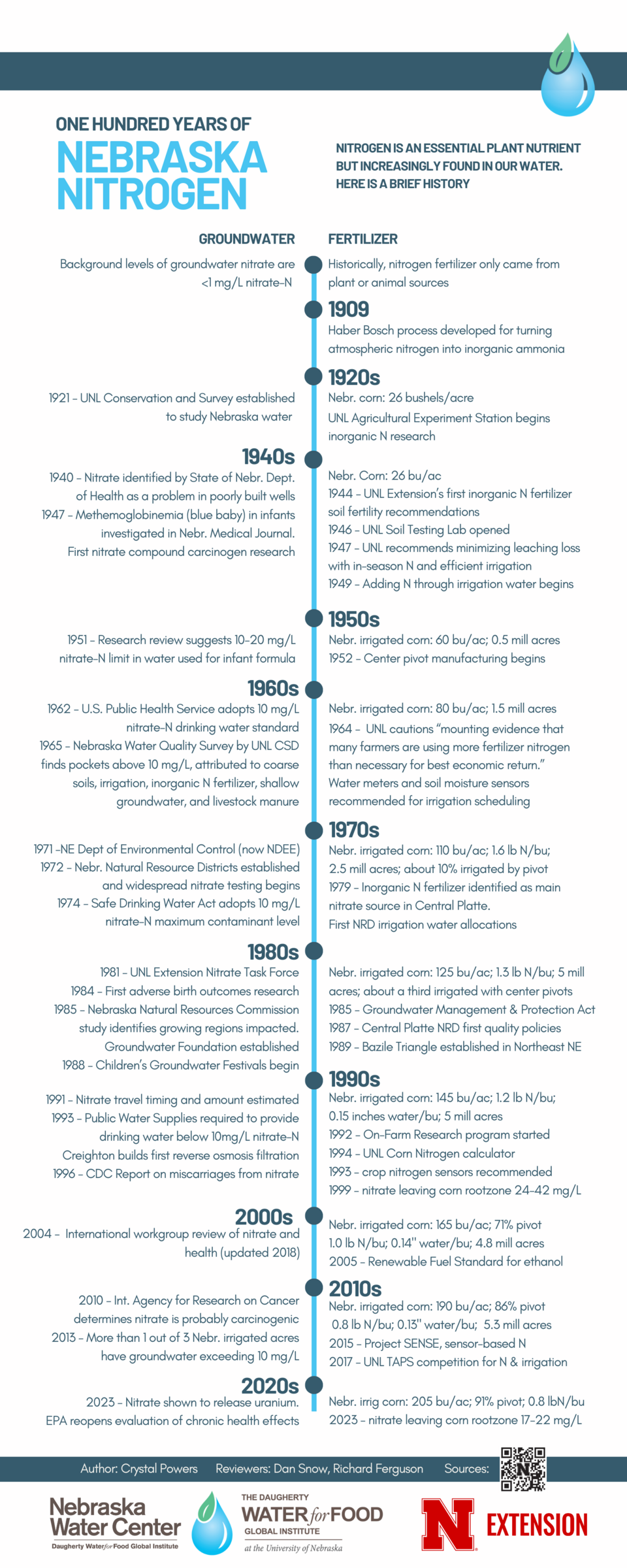100 years of Nebraska nitrogen

Nitrogen is an essential plant nutrient but increasingly found in our water. Here is a brief history:
Groundwater | Fertilizer | |
| Background levels of groundwater nitrate are | Historically, nitrogen fertilizer only came from plant or animal sources. | |
| 1909 | Haber Bosch process developed for turning atmospheric nitrogen into inorganic ammonia. | |
| 1921 - UNL Conservation and Survey established to study Nebraska water. | 1920s | Nebr. corn: 26 bushels/acre UNL Agricultural Experiment Station begins inorganic N research. |
1940 - Nitrate identified by State of Nebr. Dept. of Health as a problem in poorly built wells. 1947 - Methemoglobinemia (blue baby) in infants investigated in Nebr. Medical Journal. First nitrate compound carcinogen research. | 1940s | Nebr. Corn: 26 bu/ac 1944 - UNL Extension’s first inorganic N fertilizer soil fertility recommendations. 1946 - UNL Soil Testing Lab opened. 1947 - UNL recommends minimizing leaching loss with in-season N and efficient irrigation. 1949 - Adding N through irrigation water begins. |
| 1951 - Research review suggests 10-20 mg/L nitrate-N limit in water used for infant formula. | 1950s | Nebr. irrigated corn: 60 bu/ac; 0.5 mill acres 1952 - Center pivot manufacturing begins. |
1962 - U.S. Public Health Service adopts 10 mg/L nitrate-N drinking water standard. 1965 - Nebraska Water Quality Survey by UNL CSD finds pockets above 10 mg/L, attributed to coarse soils, irrigation, inorganic N fertilizer, shallow groundwater, and livestock manure. | 1960s | Nebr. irrigated corn: 80 bu/ac; 1.5 mill acres 1964 - UNL cautions “mounting evidence that many farmers are using more fertilizer nitrogen than necessary for best economic return.” Water meters and soil moisture sensors recommended for irrigation scheduling. |
1971 -NE Dept of Environmental Control (now NDEE). 1972 - Nebr. Natural Resource Districts established and widespread nitrate testing begins. 1974 - Safe Drinking Water Act adopts 10 mg/L nitrate-N maximum contaminant level. | 1970s | Nebr. irrigated corn: 110 bu/ac; 1.6 lb N/bu; 2.5 mill acres; about 10% irrigated by pivot 1979 - Inorganic N fertilizer identified as main nitrate source in Central Platte. First NRD irrigation water allocations. |
1981 - UNL Extension Nitrate Task Force. 1984 - First adverse birth outcomes research. 1985 - Nebraska Natural Resources Commission study identifies growing regions impacted. Groundwater Foundation established. 1988 - Children’s Groundwater Festivals begin. | 1980s | Nebr. irrigated corn: 125 bu/ac; 1.3 lb N/bu; 5 mill acres; about a third irrigated with center pivots. 1985 - Groundwater Management & Protection Act. 1987 - Central Platte NRD first quality policies. 1989 - Bazile Triangle established in Northeast NE. |
1991 - Nitrate travel timing and amount estimated. 1993 - Public Water Supplies required to provide drinking water below 10mg/L nitrate-N. Creighton builds first reverse osmosis filtration. 1996 - CDC Report on miscarriages from nitrate. | 1990s | Nebr. irrigated corn: 145 bu/ac; 1.2 lb N/bu; 0.15 inches water/bu; 5 mill acres 1992 - On-Farm Research program started. 1994 - UNL Corn Nitrogen calculator first created. 1993 - crop nitrogen sensors recommended. 1999 - nitrate leaving corn rootzone 24-42 mg/L. |
| 2004 - International workgroup review of nitrate and health (updated 2018). | 2000s | Nebr. irrigated corn: 165 bu/ac; 71% pivot; 1.0 lb N/bu; 0.14" water/bu; 4.8 mill acres 2005 - Renewable Fuel Standard for ethanol. |
2010 - Int. Agency for Research on Cancer determines nitrate is probably carcinogenic. 2013 - More than 1 out of 3 Nebr. irrigated acres have groundwater exceeding 10 mg/L. | 2010s | Nebr. irrigated corn: 190 bu/ac; 86% pivot; 0.8 lb N/bu; 0.13" water/bu; 5.3 mill acres 2015 - Project SENSE, sensor-based N. 2017 - UNL TAPS competition for N & irrigation. |
2023 - Nitrate shown to release uranium. EPA reopens evaluation of chronic health effects. | 2020s | Nebr. irrigated corn: 205 bu/ac; 91% pivot; 0.8 lb N/bu 2023 - nitrate leaving corn rootzone 17-22 mg/L. |
For the full size graphic and list of references visit: https://water.unl.edu/100-years-nebraska-nitrogen
This article was reviewed by Dan Snow and Richard Ferguson